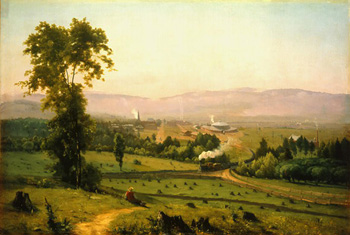THE KINGDOM OF COAL
W
ith the advent of George Scranton's blast furnaces in 1840, the city of Scranton
would become the largest producer of iron in the world. Ultimately, Scranton furnished iron for the railroad rails that would span the American continent. As prior to that time rails were imported from England at great cost, this was a great manufacturing coup. Nearby Scranton, iron and steel mines provided employment for many as laborers and miners. Pennsylvania, second only to Michigan, would eventually provide the bulk of Montana's copper and silver miners--men like Daniel O'Grady and James Lavelle. Work started at an early age in all the mines. Children as young as nine could earn two shillings a week in the dressing sheds sorting ores. Young men could shovel out rock into waiting train cars earning themselves the name "mucker" derived from "muc" the Irish word for pig. Those who sorted coal in the collieries or coal breakers were known as �breaker boys� and if you drove mules you were known as a �spragger�.
Coal burned hot and clean; and businessmen acquired great wealth in the late 19th century and early 20th century. The coal mine labor problems involving the Irish immigrants popularly known as the �Molly Maguires� was generally located further south of this area. History buffs may recall that about 20 of them were hanged in Pottsville, Pennsylvania. Lackawanna County was pretty much spared �Molly Maguire� activity.
The town of Carbondale was actually the first area the Irish settled in so they could work the Delaware and Hudson Canal and the Gravity Railroad. The railroad connected the settlement of Carbondale to the canal at Honesdale, Pennsylvania. The canal allowed for transportation of coal to market in New York City. On the gravity railroad, stationary steam engines pulled coal cars up inclines to a plane where the stationary steam engines were situated, while gravity aided the cars in descending the slopes. In 1827, the D & H Canal Company tired using an imported English steam engine, The Stourbridge Lion, for motive power. It, however, was too heavy for the wooden track. This was the first steam locomotive to run in America.
When the Scranton brothers arrived in Slocum Hollow, there were five houses. By 1840, with the start of their Lackawanna Iron and Coal Company, the Irish began to settle in the area now known as Scranton, to work on the iron blast furnaces and railroad. [The Lackawanna Iron and Coal Company would move to Buffalo, NY in 1902 to be closer to current sources of iron ore; coke from bituminous coal having become the preferred fuel.]
One of the earliest Scranton neighborhoods, which exists to this day, was Providence. It was here the first Lavelle's would settle.
In his 1869 "History of the Lackawanna Valley," Dr. Hollister describes the development of Providence township and its relation to Scranton. Providence was one of two townships laid out in 1770, and was named for the major town in the Colony of Rhode Island. Hollister had this to say of early Providence, PA: "The houses, beginning to gladden the waste places, had but a single story, where built from green logs up-rolled and chinked with mud, to protect the inmates from cold, and gave one-third of this space to huge stone chimneys. There was not in the entire township, in 1775, so strange a feature as three houses in a cluster, or two within sight of each other.
|


